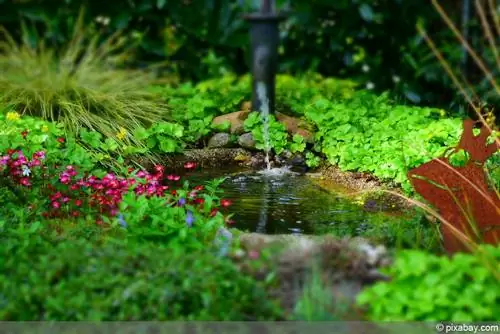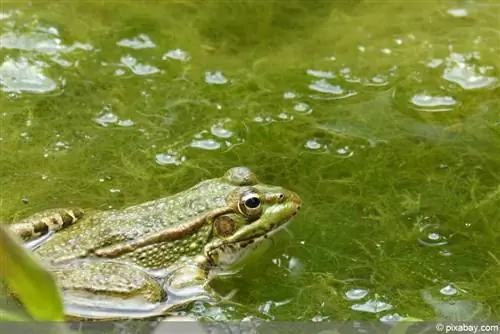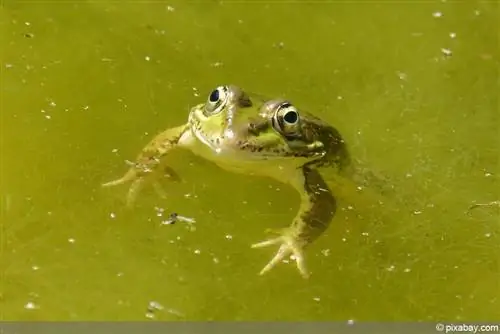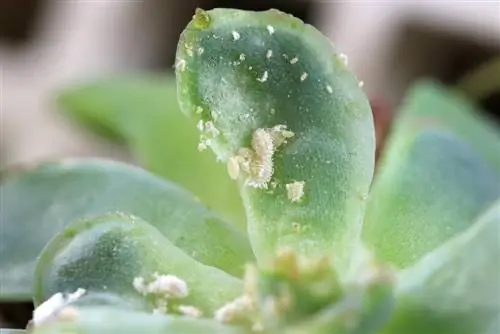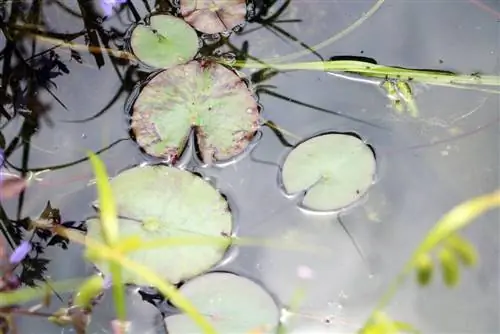- Author admin [email protected].
- Public 2023-12-17 03:39.
- Last modified 2025-06-01 06:48.
Under good conditions, green algae can multiply explosively and en masse. The water is slowly becoming greener and cloudier. The visibility is severely limited. These floating algae are usually caused by too many nutrients in the water and too much light.
Responsible algae species
Green Dot Algae
Green dot algae form green dots on the aquarium glass and on the leaves of slow-growing plants. They are very hard algae, which is why they are rarely eaten. The zebra racing snail is helpful. The algae can be scraped off the disc with a blade. In order to suppress the algae, there should not be too much nutrient in the water, so reduce the fish population, do not feed them too much and, if possible, change the water at least 30 percent weekly.
Thread algae
Thread algae are thread-like structures of different lengths. The threads can be long, up to 30 cm, which is a lot for an aquarium. However, they are also easily removed by wrapping them around an unpainted stick that is dragged through the water. Plants are competitors for food and should be abundant. Algae eaters also play their part in the decimation.
Fur algae
Furz alters settle on the aquarium floor, on leaves and decorative objects and form a dense carpet up to 3 cm high. These algae grow very quickly. They cannot be removed manually. The trigger can be lighting for more than 12 hours per day. In addition, fur algae often occur in aquariums with little or no plant growth.
Hair algae
Hair algae form cotton ball-like or cushion-like structures up to a size of around 4 cm. Plant growth helps against hair algae, and the algae are also eaten by fish and invertebrates.
Lint algae
Fusselalgae the fuzzy-looking algae prefer to grow on leaves and stems of plants. These are often weakened. A mild appearance is normal and not cause for concern. Since these algae are readily accepted by algae eaters, they can easily be decimated.
Fighting green algae is not easy. There are quick remedies that can be used, but they only provide short-term relief and can actually worsen the problem in the longer term. It is better to take consistent countermeasures, even if it requires time and energy, and to find a longer-term solution.
Fighting green algae in the aquarium - what can you do?
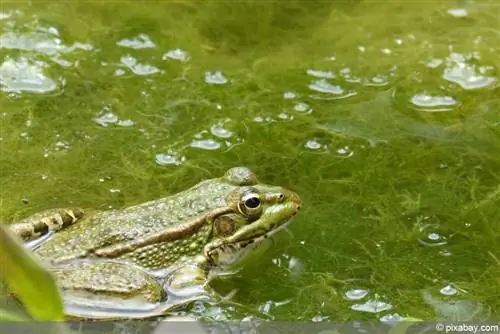
In the aquarium, strong algae growth often occurs when there is too much phosphate and too much ammonium in the water. Since most aquariums only contain a few plants and they do not manage to absorb all the nutrients, many are left over. The algae that are already present begin to multiply. The water is becoming greener and greener, the fish can hardly be seen anymore.
Darken aquarium
Green algae need light. If they don't get that, they die. For an aquarium, completely covering it, i.e. darkening it, helps. Of course, the lighting must also be turned off. Two things are important: the water must be changed as much as possible and ventilation must be ensured. Oxygen levels for the fish are important. The blackout should be maintained for 4 to 7 days.
UVC water clarifier
The water clarifiers are controversial and their use needs to be carefully considered. In any case, continuous use is not recommended, as not only the algae are killed, but also the bacteria, which in turn are responsible for the decomposition of the algae. In addition to algae, parasites and floating bacteria are also killed. A water change is usually recommended after use.
Diatom filter
A diatom filter (diatom filter) is suitable for quickly cleaning the water. It filters out the floating algae quickly, but often gets clogged in the process. It is better to monitor him as he works and, if necessary, clean the filter again and again.
Use water fleas
Water fleas live on algae. If you have the opportunity to remove the fish from the aquarium, the problem can be easily combated. You should remove the fish so that they do not overeat.
Fighting green algae in the pond
The green color of pond water also comes from the explosive proliferation of green algae. Here it is too much sun, which warms the water excessively, that is to blame. It heats up very quickly and strongly, especially in shallow ponds. However, an oversupply of nutrients is often to blame for garden ponds. The combination of too much sun and too many nutrients causes an extreme increase in green algae, clouding of the water and green discoloration. First, the causes of this proliferation must be found so that they can be stopped.
Causes of green algae in the pond
There are several reasons that can trigger it. Often it is a combination of several things. The pond can usually cope with one cause itself, but if they accumulate, it is overwhelmed and needs help. A he althy pond helps itself. If it doesn't do this, the ecological balance is disturbed, something is wrong. There are usually too many nutrients in the water. There are various reasons for this:
- Too many fish, therefore too much fish excrement
- Too much fish food that wasn't eaten
- Too much sunlight
- Too few plants, both border plants and aquatic and floating plants
- Lots of mud on the ground, consisting of dead plant material, leaves, washed-in soil, dust, etc. Decomposition produces a lot of nutrients.
- Dead plants in the water and on the bank
- Heavy rain that washes soil into the pond and at certain times rainwater contains many nutrients, e.g. pollen
- Well water used for the pond can contain a lot of phosphorus
- Lack of filter system, especially when stocked with fish
Quick help with green algae
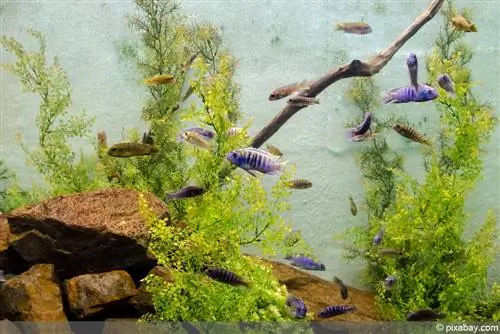
A UVC primary clarifier provides quick help. If there is an existing filter system, this can be placed in front of the actual filter. In the clarifier, the suspended algae are “clumped” by UV light. These bundles can be filtered out by the pond filter. With the larger particles, the filter does not have the problem that occurs with microscopic algae. They just slip through.
Tip:
The wattage of the UVC lamp is crucial for its effectiveness. 1 to 2 watts are required per thousand liters of water. If there are fish in the pond, it is 2 to 3 watts per thousand liters, in koi ponds even 4 to 5 watts. In addition, the lamps should be changed annually.
Algae control agents also do a good job quickly, but not permanently. There are different algae control agents. You should definitely follow the operating instructions for all of them. Overdoses must be avoided.
Chemical flocculants with the active ingredients iron chloride or aluminum s alts work quite well. They ensure that the floating algae stick together by clumping together to form large flakes and so they can be disposed of through the pond filter. If the flakes sink to the bottom of the pond, they subsequently serve as nutrients for other algae. Flocculants work quickly and are harmless to other pond inhabitants.
A water change is often recommended. However, it must be said that fresh water also contains a lot of nutrients, so it doesn't always make sense. The water quality is crucial. Rainwater is quite acidic. If it hasn't rained for a long time, dust, including pollen, collects on the roofs. The rain washes these nutrients away and into the collection container. This is how they get into the pond. Well water also often contains nutrients and even normal tap water has its pitfalls. A water test provides information about the water quality.
Long-term solution=eliminating causes
It's best to test the water in the pond first. You can usually find out quite well from the water parameters why the green algae multiply so much. A water sample does not necessarily have to be sent in for analysis; a water analysis set is also sufficient. These are available commercially with good instructions. Good water quality is characterized by the following values:
- pH value - 7 to 8
- Nitrite (NO2) < 0. 15 mg/l
- Nitrate (NO3) < 0.50 mg/l
- KH value - 5 to 12
- GH value - 8 to 12
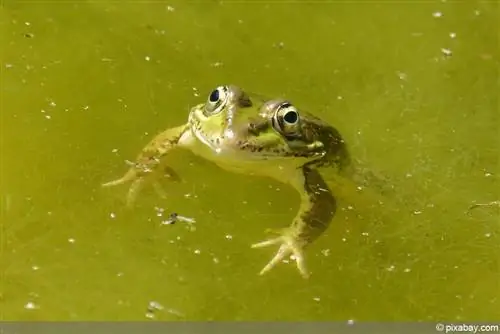
Once the values have been determined and compared, countermeasures can be initiated. Water conditioners can be used to balance the values. Then it is important to eliminate the causes.
- Too few plants in the pond - use aquatic plants and floating plants, including fast-growing ones if possible. They are competitors for food.
- Too much sun - shade the pond
- Too much mud at the bottom of the pond - find out the cause
- Pond soil for planting - do not plant in soil, not even in pond soil. Most aquatic plants also thrive in gravel or between pebbles
- Leaves - fish leaves in autumn if possible every day so that they do not sink to the ground, set up a leaf protection net, move deciduous trees, plant evergreen trees instead (shading)
- Soil washed in - install capillary barrier, remove some soil all around so that the edge of the pond is higher
- Dust, pollen - cannot be prevented, but is cleared through a filter
- Remove mud from the pond by hand or with a mud vacuum. The best time for this is spring.
- Missing pond filter - installation of a filter system appropriate to the size and stock
- Too much fish - there should be no more than 3 kg of fish per 1,000 liters of water. Catch some fish and give them away! Fishless ponds are much easier to maintain. Biological balance is easier to maintain.
- A lot of unused fish food - feed less
- Dead fish or invertebrates in the water - fish them out
- Dead plant material - Check bank vegetation regularly and remove dead plants or parts of them. Also check the plants in the water.
- Dead algae - must be removed as they release enormous amounts of nutrients as they decompose
Conclusion
Green algae occurs in every pond or aquarium. They don't cause any trouble as long as they don't reproduce en masse. There are countermeasures that work quite quickly, but they usually only help for a short time and can subsequently worsen the water quality. It is better to find out the cause and eliminate it. A lot of things can also be done preventatively. You should take certain things into account when planning so that there is no risk of an excess of nutrients later. Advice from an expert can be of great help. In addition, both aquariums and ponds need to be maintained regularly and usually intensively. The water only very, very rarely stays clear on its own.

